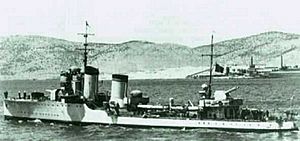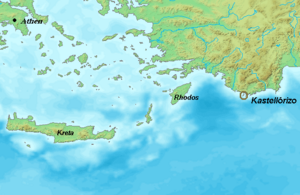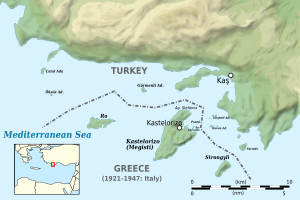Operation Abstention facts for kids
Quick facts for kids Operation Abstention |
|||||||
|---|---|---|---|---|---|---|---|
| Part of the Battle of the Mediterranean of the Second World War | |||||||
 Italian destroyer Francesco Crispi |
|||||||
|
|||||||
| Belligerents | |||||||
| Commanders and leaders | |||||||
| Strength | |||||||
| 2 light cruisers 7 destroyers 1 gunboat 1 submarine 1 armed yacht 200 commandos 200 soldiers and marines |
2 destroyers 2 torpedo boats 2 MAS boats SM.79 bombers SM.81 bombers 280 soldiers 88 marines |
||||||
| Casualties and losses | |||||||
| 5 killed 10 wounded 20 captured or interned 7 missing 1 destroyer damaged 1 gunboat damaged |
14 killed 12 captured |
||||||
Operation Abstention was a secret plan by the British during the Second World War. In February 1941, they tried to invade Kastelorizo, a small Greek island controlled by Italy. This island is located near the coast of Turkey in the Aegean Sea.
The main goal of this operation was to set up a base for fast attack boats. These boats would help the British challenge Italy's control of the sea and air around the nearby Dodecanese islands. However, Italian forces on land, in the air, and at sea fought back strongly. This forced the British troops to leave the island in a hurry. The British commanders later argued about why they had underestimated the Italian forces.
Contents
Why the British Attacked Kastelorizo
After some successful battles against Italy, the British wanted to weaken Italian forces in the Dodecanese islands. These islands were important for controlling the Aegean Sea.
Admiral Andrew Cunningham, who led the British Mediterranean Fleet, decided to capture Kastelorizo. It was the easternmost Greek island, about 80 nmi (148 km) from Rhodes, a major Italian base. The British hoped to build a base for motor torpedo boats there. This was especially important because their air base on Malta was under heavy attack. Taking Kastelorizo was seen as a first step to gaining control of the Aegean Sea. Even though they were somewhat isolated, Italian forces in the area could still launch quick attacks on Allied ships.
The Battle for the Island
February 24: The Plan Begins
The British planned to land about 200 special forces soldiers, called No. 50 Commando, along with 24 Royal Marines. Their job was to secure a landing spot on the island. A day later, a larger army unit would arrive to strengthen the British position.
On February 24, the commandos sailed from Suda Bay on two destroyers, HMS Decoy and Hereward. The marines traveled on a gunboat called HMS Ladybird. A second group of soldiers, from the Sherwood Foresters regiment, waited in Cyprus. They were on an armed yacht, HMS Rosaura, escorted by two light cruisers, HMAS Perth and HMS Bonaventure.
February 25: British Landings and Italian Response
Before sunrise, 50 commandos landed quietly on Nifti Point, south of the main town. The Royal Marines took control of the harbor. A British submarine, HMS Parthian, had scouted the area and helped guide the ships.
The Italian soldiers on Kastelorizo were a small group of 35 men. The British commandos surprised an Italian patrol, killing two soldiers and wounding one. They quickly captured the Italian radio station and took 12 prisoners. However, the Italians managed to send a message to Rhodes before being captured.
Admiral Luigi Biancheri, the Italian naval commander in the Aegean Sea, reacted quickly. Italian planes from the Regia Aeronautica (Royal Italian Air Force) attacked the harbor and hills where the commandos were dug in. The British gunboat Ladybird was hit by a bomb, wounding three sailors. Because it was low on fuel, Ladybird had to leave for Haifa, taking the Royal Marines with it. This cut off the commandos' radio link to their base. Due to communication problems, the second British force waiting in Cyprus was sent back to Alexandria instead of Kastelorizo.
February 26: Italian Counter-Attack
The Regia Marina (Royal Italian Navy) launched its counter-attack after sunset on February 26. Two Italian torpedo boats, Lupo and Lince, landed about 240 soldiers north of the port. They used their guns to shell British positions, killing three commandos and wounding seven. The Italian warships also rescued some Italian civilians who had gathered at the harbor.
February 27: More Italian Troops Arrive
Admiral Biancheri landed more troops on the morning of February 27, despite rough seas. Italian forces already on the island attacked the tired British commandos. The British soldiers were only equipped for a 24-hour mission.
Later that day, two Italian destroyers, Francesco Crispi and Quintino Sella, arrived with even more soldiers. In total, 258 soldiers and 80 marines were landed by Italian ships. As the Italians attacked, the commandos pulled back to their landing beach at Nifti Point. One group stayed near the local cemetery.
The captain of the British destroyer Hereward was warned about the Italian attack. He joined Decoy about 40 nmi (74 km) off the coast. The British commander ordered the destroyers to stop the Italian landings. However, they could not find the Italian ships. The British main force, on Rosaura, was supposed to land but air attacks had already made it too risky. The landing was delayed and then rearranged. The ships were ordered to Alexandria to reorganize. The British commander, Admiral Renouf, became ill and was replaced, which made things more difficult.
February 28: British Withdrawal
More British forces arrived from Alexandria early on February 28. A group of Sherwood Foresters found the landing point abandoned by the commandos. They found scattered equipment, ammunition, a dead soldier, and two stragglers. These two told them about the Italian counter-attack.
Major Cooper of the Sherwood Foresters decided that without enough naval and air support, they had to leave. Most of the British landing party, who were stuck on a small plateau, were taken off the island by 3:00 AM. Italian troops surrounded and captured some commandos who had been left behind.
While covering the withdrawal, the British destroyer HMS Jaguar was attacked by the Italian destroyer Crispi. Crispi fired shells at British positions and launched two torpedoes, which missed. Jaguar fired back. Jaguar was hit, damaging its searchlight, and the British ships sailed back to Alexandria. Other British destroyers searched the area between Rhodes and Kastelorizo but did not find the Italian warships returning to their base.
Aftermath
The British suffered 5 killed, 10 wounded, 20 captured, and 7 missing. One destroyer and one gunboat were damaged. The Italians had 14 killed and 12 captured. The operation was considered an Italian victory.
Images for kids
See also
- Convention between Italy and Turkey, 1932
- Balkans Campaign
- Dodecanese Campaign
- Operation Mandibles




